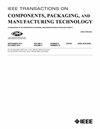ZrO2纳米粒子封装提高白光二极管总光通量
IF 3
3区 工程技术
Q2 ENGINEERING, ELECTRICAL & ELECTRONIC
IEEE Transactions on Components, Packaging and Manufacturing Technology
Pub Date : 2025-07-25
DOI:10.1109/TCPMT.2025.3592673
引用次数: 0
摘要
近年来,白光发光二极管(led)由于其高能效和高性能,在普通照明和显示领域获得了广泛的应用。二氧化锆纳米粒子(ZrO ${}_{{2}}$)具有高折射率的特点,可以显著提高白光led的发光效率。通过将少量的ZrO ${}_{{2}}$纳米粒子集成到白光LED封装(PKG)的封装树脂中,有效地散射LED芯片发出的光,从而增强PKG的光提取能力。通过射线追踪模拟研究了ZrO ${}_{{2}}$纳米粒子在白光LED封装(PKG)中的光学行为,优化了ZrO ${}_{{2}}$纳米粒子的分布,并分析了其发光增强的机理。模拟结果表明,ZrO ${}_{{2}}$纳米颗粒,特别是在50 - 100 nm范围内,在白光LED制造中显着提高了亮度,同时减少了荧光粉的使用。本文章由计算机程序翻译,如有差异,请以英文原文为准。
Encapsulation of ZrO2 Nanoparticles for Improving Total Luminous Flux of White Light-Emitting Diodes
In recent years, white light-emitting diodes (LEDs) have gained traction in general lighting and displays owing to their energy efficiency and high performance. Zirconium dioxide (ZrO ${}_{{2}}$ ) nanoparticles, characterized by high refractive indices, can significantly improve the luminous efficiency of white LEDs. When integrated into the encapsulation resin of white LED packaging (PKG), a small quantity of these nanoparticles effectively scatters the light emitted by the LED chip, thereby enhancing light extraction from the PKG. A ray-tracing simulation was employed to study the optical behavior of ZrO ${}_{{2}}$ nanoparticles within white LED PKG. Subsequently, the distribution of the ZrO ${}_{{2}}$ nanoparticles was optimized, and the mechanism underlying the enhanced luminosity was analyzed. The simulation results reveal that ZrO ${}_{{2}}$ nanoparticles, particularly in the 50–100-nm range, significantly enhance luminosity while reducing phosphor usage in white LED manufacturing.
求助全文
通过发布文献求助,成功后即可免费获取论文全文。
去求助
来源期刊

IEEE Transactions on Components, Packaging and Manufacturing Technology
ENGINEERING, MANUFACTURING-ENGINEERING, ELECTRICAL & ELECTRONIC
CiteScore
4.70
自引率
13.60%
发文量
203
审稿时长
3 months
期刊介绍:
IEEE Transactions on Components, Packaging, and Manufacturing Technology publishes research and application articles on modeling, design, building blocks, technical infrastructure, and analysis underpinning electronic, photonic and MEMS packaging, in addition to new developments in passive components, electrical contacts and connectors, thermal management, and device reliability; as well as the manufacture of electronics parts and assemblies, with broad coverage of design, factory modeling, assembly methods, quality, product robustness, and design-for-environment.
 求助内容:
求助内容: 应助结果提醒方式:
应助结果提醒方式:


